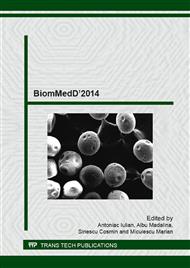[1]
Lehmann L.E., Hunfeld K.P., Emrich T., Haberhausen G., Wissing H., Hoeft A., Stuber F., A multiplex real-time PCR assay for rapid detection and differentiation of 25 bacterial and fungal pathogens from whole blood samples, Med. Microbiol. Immunol., 197: 313-324, (2008).
DOI: 10.1007/s00430-007-0063-0
Google Scholar
[2]
Mariconda M., Ascione T., Balato G., Rotondo R., Smeraglia F., Costa G.G., Conte M., Sonication of antibiotic-loaded cement spacers in a two-stage revision protocol for infected joint arthroplasty, 14: 193, (2008).
DOI: 10.1186/1471-2474-14-193
Google Scholar
[3]
Trampuz A., Piper K.E., Jacobson M.J., Hanssen A.D., Unni K.K., Osmon D.R., Mandrekar J.N., Cockerill F.R., Steckelberg J.M., Greenleaf J.F., Patel R., Sonication of Removed Hip and Knee Prostheses for Diagnosis of Infection, D. N Engl J Med, 357: 654-663, (2007).
DOI: 10.1056/nejmoa061588
Google Scholar
[4]
Panousis K., Grigoris P., Butcher I., Rana B., Reilly J.H., Hamblen D.L., Poor predictive value of broad-range PCR for the detection of arthroplasty infection in 92 cases , Acta Orthop. 76: 341-346, (2005).
DOI: 10.1080/00016470510030805
Google Scholar
[5]
Achermann Y, Vogt M, Leunig M, Wüst J, Trampuz A. Improved Diagnosis of Periprosthetic Joint Infection by Multiplex PCR of Sonication Fluid from Removed Implants, February 2010, J. Clin. Microbiol. April 2010 vol. 48; 4: 1208-1214.
DOI: 10.1128/jcm.00006-10
Google Scholar
[6]
De Man, F. H., P. Graber, M. Luem, W. Zimmerli, P. E. Ochsner, and P. Sendi. 2009. Broad-range PCR in selected episodes of prosthetic joint infection, Infection 37: 292-294.
DOI: 10.1007/s15010-008-8246-1
Google Scholar
[7]
Vandercam, B., S. Jeumont, O. Cornu, J. C. Yombi, F. Lecouvet, P. Lefevre, L. M. Irenge, and J. L. Gala. 2008. Amplification-based DNA analysis in the diagnosis of prosthetic joint infection.J. Mol. Diagn. 10: 537-543.
DOI: 10.2353/jmoldx.2008.070137
Google Scholar
[8]
Rochford E T J., Richards R.G., Moriarty T F. Influence of material on the development of device-associated infections. Clincal Microbiology and infection 2012, 18: 1162-1167.
DOI: 10.1111/j.1469-0691.2012.04002.x
Google Scholar
[9]
Antoniac I., Biologically responsive biomaterials for tissue engineering, Ed. Springer, ISBN 978-1-4614-4327-8, (2013).
Google Scholar
[10]
Togan V., Ionita G., Antoniac I., Corrosion Behavior of Ti6Al4V Coated with SiOx by PECVD Technology, Key Engineering Materials, vol. 583, pp.22-27, (2014).
DOI: 10.4028/www.scientific.net/kem.583.22
Google Scholar
[11]
Ionescu R., Cristescu I., Dinu M., Saban R., Antoniac I., Vilcioiu D., Clinical, Biomechanical and Biomaterials Approach in the Case of Fracture Repair Using Different Systems Type Plate-Screw, Key Engineering Materials, vol. 583, pp.150-154, (2014).
DOI: 10.4028/www.scientific.net/kem.583.150
Google Scholar
[12]
Bane M., Miculescu F., Blajan A.I., Dinu M., Antoniac I., Failure analysis of some retrieved orthopedic implants based on materials characterization, Solid State Phenomena, vol. 188, p, 114-117, (2012).
DOI: 10.4028/www.scientific.net/ssp.188.114
Google Scholar
[13]
Antoniac V., Necsulescu A., Cosmeleata G., Biomaterials and shape memory alloys, in Materials Science and Engineering Handbook (in romanian), vol., pp.1463-1494, Ed. AGIR, 2009, ISBN 978-973-720-261-1.
Google Scholar
[14]
Donlan R.M., New approaches for the characterization of prosthetic joint biofilms. Clin Orthop Relat Res 437: 12-19, (2005).
Google Scholar
[15]
Zimmerli W, Trampuz A, Ochsner PE. Prosthetic-joint infections. N Engl J Med 2004; 351: 1645-54.
DOI: 10.1056/nejmra040181
Google Scholar
[16]
Trampuz A., Osmon DR, Hanssen AD, Steckelberg JM, Patel R. Molecular and antibiofilm approaches to prosthetic joint infection. Clin Orthop Relat Res. 2003 Sep; (414): 69-88.
DOI: 10.1097/01.blo.0000087324.60612.93
Google Scholar
[17]
Bernard L, Lubbeke A, Stern R, et al. Value of preoperative investigations in diagnosing prosthetic joint infection: retrospective cohort study and literature review. Scand J Infect Dis 2004; 36: 410-416.
DOI: 10.1080/00365540410015240
Google Scholar
[18]
Sperling, J. W., T. K. Kozak, A. D. Hanssen, and R. H. Cofield. Infection after shoulder arthroplasty. Clin. Orthop. Relat. Res. . 2001; 382: 206–216.
DOI: 10.1097/00003086-200101000-00028
Google Scholar
[19]
Gristina, A. G. Biomaterial-centered infection: microbial adhesion versus tissue integration. Science 1987 237: 1588–1595.
DOI: 10.1126/science.3629258
Google Scholar
[20]
Del Pozo, J. L., and R. Patel. Clinical practice. Infection associated with prosthetic joints. N. Engl. J. Med. 2009. 361: 787–794.
DOI: 10.1056/nejmcp0905029
Google Scholar
[21]
Sendi P, Frei R, Maurer T B, Trampuz A, Zimmerli W, Graber P Escherichia coli Variants in Periprosthetic Joint Infection: Diagnostic Challenges with Sessile Bacteria and Sonication, J Clin Microbiol. 2010 May; 48(5): 1720–1725.
DOI: 10.1128/jcm.01562-09
Google Scholar
[22]
Costerton, W., R. Veeh, M. Shirtliff, M. Pasmore, C. Post, and G. Ehrlich. 2003. The application of biofilm science to the study and control of chronic bacterial infections. J. Clin. Invest. 112: 1466-1477.
DOI: 10.1172/jci200320365
Google Scholar
[23]
Van Houdt, R., and C. W. Michiels. Role of bacterial cell surface structures in Escherichia coli biofilm formation. Res. Microbiol. 2005. 156: 626-633.
DOI: 10.1016/j.resmic.2005.02.005
Google Scholar
[24]
Ashby, M. J., J. E. Neale, S. J. Knott, and I. A. Critchley. Effect of antibiotics on non- growing planktonic cells and biofilms of Escherichia coli. J. Antimicrob. Chemother. 1994. 33: 443-452.
DOI: 10.1093/jac/33.3.443
Google Scholar
[25]
Maconda M, Ascione T, Balato G, Rotondo R Smeraglia F, Costa GG, and Conte M, Sonication of antibiotic-loaded cement spacers in a two-stage revision protocol for infected joint arthroplasty BMC Musculoskelet Disord. 2013; 14: 193.
DOI: 10.1186/1471-2474-14-193
Google Scholar


